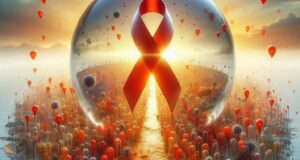Imagine a quiet village under the cover of night. A stranger enters, unnoticed, settling in quietly. Days pass before the villagers begin to realize something is wrong. They feel it in their bones. They raise an alarm. That moment when they finally recognize the threat—that’s seroconversion.

In the world of HIV, seroconversion is a turning point, a whisper before the storm. It is the period when the human body first detects the presence of HIV and starts producing antibodies—the soldiers of the immune system. These antibodies don’t eliminate the virus, but they mark its arrival. It’s the body’s first signal that an invader has breached its defenses.
To fully grasp the significance of seroconversion, we must return to an ever-echoing question: AIDS – where did it come from?
This question has puzzled scientists for decades. AIDS, or Acquired Immunodeficiency Syndrome, is caused by the HIV virus, which is believed to have originated from chimpanzees in Central Africa, possibly during the early 1900s, when humans came into contact with infected blood while hunting. From there, it journeyed silently across borders and generations—until it exploded into public awareness in the 1980s.
But HIV doesn’t knock on the door loudly. It slips into the bloodstream like a thief, invisible to early detection. During the first days or weeks, a person may feel perfectly healthy, even though the virus is multiplying rapidly.
Then, seroconversion begins—like a fog lifting. It’s as if the body suddenly realizes: “There’s an intruder here.” The immune system scrambles to respond, and antibodies against HIV begin to appear in the blood. This typically happens within 2 to 4 weeks after exposure, but for some, it may take longer.
This phase can be dramatic or silent. Some people experience flu-like symptoms: fever, rash, sore throat, night sweats, or fatigue. It’s like the village putting up its defenses, lighting torches, and shouting to warn others.
Why is seroconversion so important? Only after seroconversion does HIV become “detectable” through standard antibody-based tests. This is the moment when diagnosis becomes possible. But many people don’t realize they’ve been infected, because symptoms are mild or mistaken for a regular virus.

And that’s the danger. When people ask, AIDS – where did it come from?, the real fear lies not just in the virus’s origin, but in its stealth. HIV thrives in uncertainty and delay. It uses time as its weapon, and seroconversion is often the only signpost we have in those early, critical days.
Once seroconversion happens, the body settles into what is called the chronic HIV stage. The virus doesn’t go away, but it slows down. It’s not defeated, only hiding. Without treatment, this stage can last for years—eventually leading to AIDS, when the immune system is severely weakened.
But with early detection—thanks to knowing about seroconversion—and antiretroviral therapy (ART), people can live long, full lives. That’s why understanding this process is crucial. Seroconversion isn’t just a biological event—it’s a lifesaving clue.
So again, we ask: AIDS, where did it come from? It came not just from across borders, but through invisible stages like seroconversion, where silence masked the storm. If we learn to recognize this hidden moment, we stand a better chance of stopping the spread and breaking the chain.




